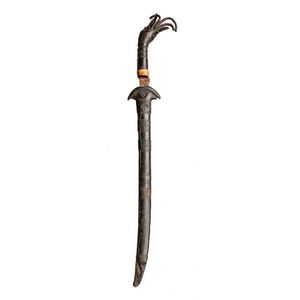Toba Batak Ceremonial Sword
You must be a subscriber, and be logged in to view price and dealer details.
Subscribe Now to view actual auction price for this item
When you subscribe, you have the option of setting the currency in which to display prices to $Au, $US, $NZ or Stg.
- Ivory - Ivory is a hard white material that comes from the tusks of elephants, mammoth, walrus and boar, or from the teeth of hippopotamus and whales. The ivory from the African elephant is the most prized source of ivory. Although the mammoth is extinct, tusks are still being unearthed in Russia and offered for sale.
Ivory has been used since the earliest times as a material for sculpture of small items, both in Europe and the east, principally China and Japan.
In Asia ivory has been carved for netsuke, seals, okimono, card cases, fan supports, animals and other figures and even as carved tusks.
In the last 200 years in Europe ivory has been used to carve figures, for elaborate tankards, snuff boxes, cane handles, embroidery and sewing accessories, in jewellery and as inlay on furniture. Its more practical uses include being used for billiard balls, buttons, and a veneers on the top of piano keys.
The use and trade of elephant ivory have become controversial because they have contributed to Due to the decline in elephant populations because of the trade in ivory, the Asian elephant was placed on Appendix One of the Convention on International Trade in Endangered Species (CITES), in 1975, and in January 1990, the African elephant was similarly listed. Under Appendix One, international trade in Asian or African elephant ivory between member countries is forbidden. Unlike trade in elephant tusks, trade in mammoth tusks is legal.
Since the invention of plastics, there have been many attempts to create an artificial ivory
This item has been included into following indexes:
Visually similar items

A Sword, Palu Palu, Central Sulawesi, Indonesia, (early twentieth century), carved wood, steel and rattan, 77.2 cm long. Provenance: Private Collection, Makassar, (Ujung Pandang). Acquired from above by Dr Peter Elliott, in the late 1970s

Papua New Guinea ceremonial dance Wand superb form with carving to the head and shaft, length 59 cm, middle Sepki, New Guinea. Provenance: Reportedly from the collection of Dr. Reichard Thurnwald 1914, Sepik river. Colonel Woodman, District Officer in the

A whaler's blubber hook, hand forged steel and wood, initialled 'B.R.', 19th century 102 cm long

Fine Fijian Club. Gata Classic form, well balanced and finely carved detailing to handle. Early deep rich patina. Length 99 cm. Width 14 cm. Provenance: T. Clemence Collection, New Zealand
